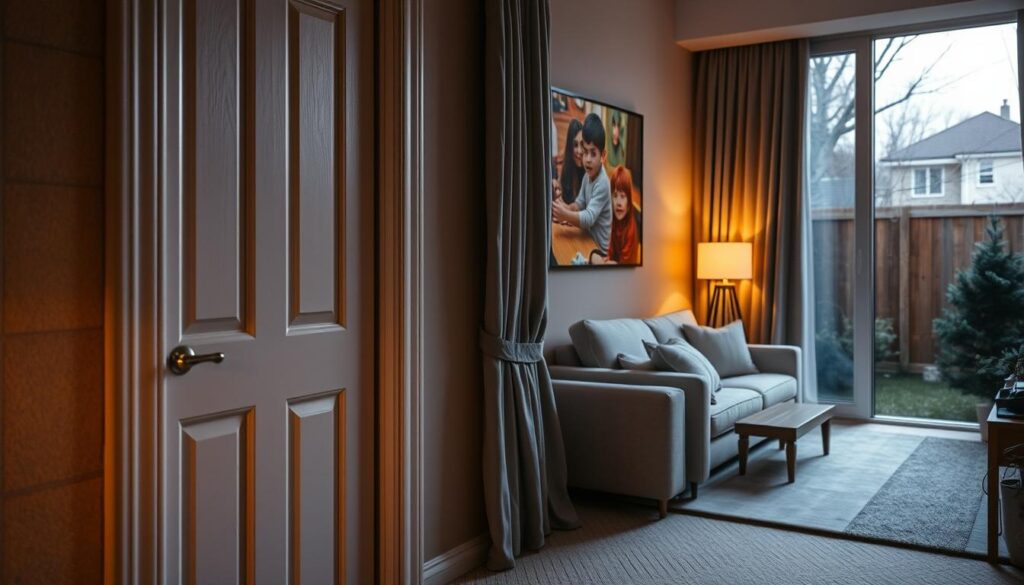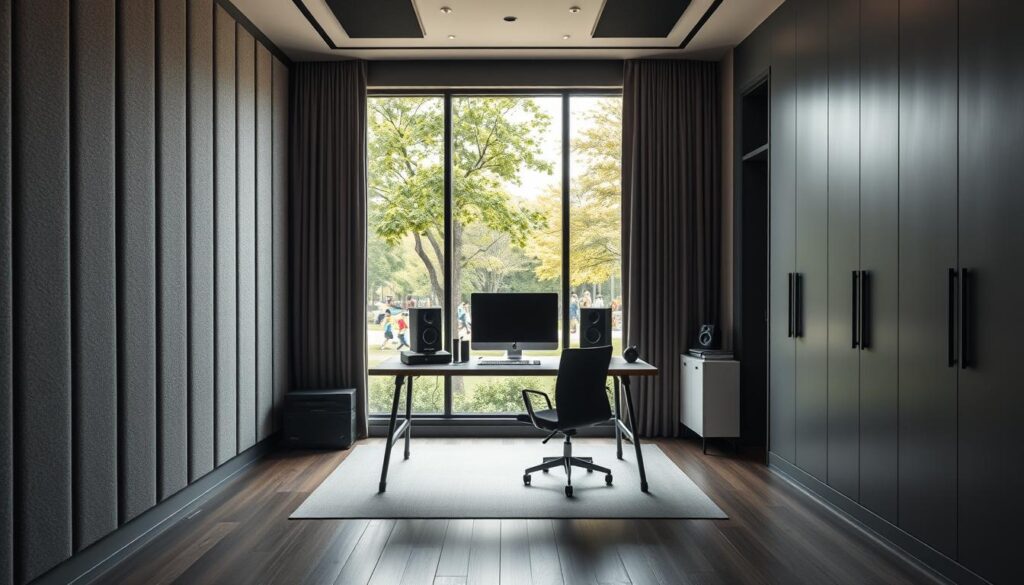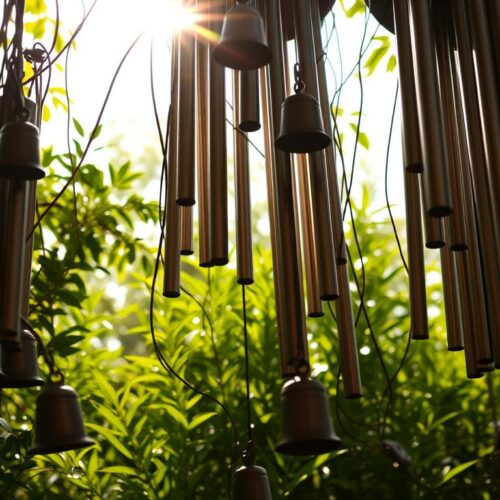Living near lively playgrounds brings a distinct challenge for your baby’s sleep. The ongoing noise from children playing and park activities can interrupt your baby’s naps. This can harm their sleep quality. Such disruptions often cause crankiness and uneven sleep schedules. It’s important to know how to handle park noise. This keeps your baby’s sleep peaceful and supports their well-being.
Understanding Playground Noise and Its Impact
Playground noise comes from kids playing, like shouting and laughing. It also includes sounds from swings and slides. Living nearby can mean hearing a lot of sounds, especially when school’s out or on weekends.
The amount of noise changes based on how many kids are there and what they’re doing. Sound levels jump right after school or during weekends. This can make it hard for babies to nap.
Keeping things quiet for babies’ sleep is important to parents. Loud noises from outside can disrupt sleep and upset routines. Learning about playground noise helps tackle these issues better.
| Time of Day | Noise Level | Potential Impact |
|---|---|---|
| Morning (before school) | Low to Moderate | Minimal disruption |
| After school | High | Significant baby nap disruption |
| Weekends | Very High | Severe impact on sleep schedules |
| Evening | Moderate to Low | Reduced noise, better sleep environment |
The Challenges of Living Close to Parks
Living near parks brings unique challenges, especially with managing park noise. Morning joggers and evening get-togethers create a constant buzz. This noise can disrupt families seeking peace at home.
A big issue is how this noise affects babies’ sleep. Parents work hard to soundproof their homes for a quiet sleep space. Keeping babies on a regular sleep schedule becomes hard with unpredictable noise day and night.
To understand this better, let’s look at common noise sources near parks:
| Source | Typical Noise Level | Time of Day |
|---|---|---|
| Playgrounds | High | Morning to Late Afternoon |
| Sports Activities | Moderate to High | Afternoon to Evening |
| Public Events | Very High | Weekend Evenings |
| General Foot Traffic | Low to Moderate | All Day |
Daily activities add to the noise, making managing it a strategic need. With this knowledge, families can better plan their homes to reduce disruptions and improve their life quality.
Strategies to Minimize Playground Noise
Living near busy parks can be tough, especially with the noise. But, there are effective ways to lessen playground noise at your home. This ensures your baby’s naps are not disturbed.
Soundproofing your home is a top solution for peace. Installing soundproof windows and doors, using heavy curtains, and looking at wall insulation can help. These steps greatly reduce noise entering your living areas.
Choosing where your baby sleeps is also key. Place the nursery in a quiet area, away from the park side if you can. This small change can greatly help in reducing park noise and improve sleep quality.
- Soundproof windows and doors
- Heavy curtains
- Wall insulation
- Optimal room placement
Besides soundproofing, sound masking devices like white noise machines can also help. They produce consistent sounds to mask outdoor noise, helping your baby sleep better. Combining these strategies can keep your home quiet and perfect for rest.
Soundproofing Your Home
Making your home a peaceful place can be hard if you live near busy parks. Soundproofing is key to keeping out park noise, so your home stays quiet. This is vital for you and your baby’s rest.
One top way to soundproof is by getting double-paned windows. They add an extra layer to block outdoor noises. Also, heavy curtains can make this even better by adding more sound blocking.
Putting more insulation in your walls helps too. Materials like fiberglass or foam soak up sound. This stops noise from getting inside. It also makes your home more energy-efficient, which is good for any family.

| Soundproofing Technique | Benefits |
|---|---|
| Double-paned Windows | Reduces external noise by adding an extra barrier; improves home insulation. |
| Heavy Curtains | Absorbs sound; easy to install; adds aesthetic value. |
| Extra Wall Insulation | Absorbs and blocks noise; enhances energy efficiency; long-term solution. |
Using these soundproofing methods makes dealing with park noise easier. It helps make your home quieter and more serene for your family.
Timing Your Outings
Try going to the park early in the morning or later in the evening. This helps avoid loud noises and keeps your baby’s nap schedule on track. Parks are usually quieter when fewer people are around.
Planning trips around quieter times makes a huge difference. By missing the busy hours, your visits will be more fun and calm for your baby. This smart planning helps keep the peace and keeps your baby’s naps regular.
Also, get to know when your local park is less crowded. It’s usually busier right after school and on weekends. Visiting during off-peak hours is great for less noise and smoother naps for your baby.
Preparing Your Baby for Sleep
Getting your baby ready for sleep near busy places means being gentle but firm.
Dim the lights in your baby’s room to start a peaceful atmosphere. Soft lights tell the brain it’s sleep time, making it easier to rest. Then, give your baby a warm bath. It relaxes them and is a good end to a playful day.
Playing soft music is another good step. Lullabies or white noise can block out loud playground sounds. This smooth background sound keeps sleep from getting interrupted.
Keeping a regular sleep schedule is crucial. It teaches your baby when it’s time to sleep. Stick to routines like the same bedtime or bath time every night. This predictability sets their internal clock and makes sleep prep better.
These steps do more than get your baby ready for sleep. They also start healthy sleeping habits.
Choosing the Right Location
Finding the perfect spot for your baby’s nursery is key to a calm sleeping spot. Aim for quiet, secluded areas when picking a spot in your home. Picking a room away from busy streets and loud neighbors helps lessen noise.
To lessen noise inside, think about both outside and inside sounds. A room in the center of your home is quieter than one near a busy street. Look at your home’s layout and put the nursery where it’s quietest.
Making sure the nursery is peaceful involves good insulation and soundproofing. This means putting in heavy curtains, soundproof panels, and rugs. These steps help make the best sleeping area for your baby.
Using Technology to Your Advantage
Modern technology can change the game by reducing playground noise. Specially made windows and doors help block outside sounds. Also, smart systems control blinds and temperature, making inside quieter.
White noise machines help too. They make calming sounds that cover up outdoor noise. This lets your baby sleep without being disturbed. They’re an easy and effective way for you to keep things quiet.
Use soundproofing tech like insulated curtains and rugs with white noise machines. This mixes different methods to fight noise. It turns your home into a calm place for you and your baby.

It’s not just about one fix, but using many tech solutions together. Soundproofing materials and white noise machines balance each other. This way, you can live near playgrounds but still have peace.
Engaging with Your Community
Getting everyone involved is key to handling park noise and making sure neighbors are comfortable near playgrounds. Working with your local community or homeowner’s association is a smart move. This way, you can tackle noise issues together. For example, talking about playground rules with neighbors and officials can lead to changing playground hours. This could help keep the noise down when your baby needs to rest.
Joining forces can make a big difference in noise control. Why not have neighborhood meetings to talk about ways to lower noise? You could discuss putting up sound barriers or having quiet times. This ensures everyone’s concerns are heard and keeps the neighborhood nice for all.
Being active in your community does more than just ease noise issues; it also builds unity and teamwork. By taking steps together, you can find solutions that work well for everyone. This leads to a peaceful and happy environment for all involved.
| Strategy | Description | Benefits |
|---|---|---|
| Community Meetings | Organize regular discussions with residents and local authorities | Identify and implement effective noise management solutions |
| Sound Barriers | Install walls or fences to reduce noise transmission | Minimize disruption during rest hours |
| Quiet Hours | Set designated times when playground noise is minimized | Ensure peace during critical rest periods |
Health Considerations Related to Noise
Understanding how noise affects health in places like playgrounds is key. Long-term noise can harm your family’s health, including children’s hearing. Loud places can delay kids’ speech and language growth.
Constant noise also raises stress, harming mental health and life quality. Keeping children’s ears safe is essential.
Reducing playground noise helps both now and in the future. Soundproofing and noise-canceling tech can lower indoor noise. This protects kids’ hearing and brings peace.
Tackling noise pollution is critical for family well-being. It lets everyone live in a healthier, calmer place.
Navigating Park Policies
Knowing park policies is key, especially if you live near a playground. Rules about operating hours and noise are set to meet everyone’s needs. Learning these playground regulations helps manage noise from nearby fun areas.
Park policies include rules on activity times, noise types, and how rules are enforced. Being involved with local decisions can make these rules more community-friendly. Understanding community noise laws lets you express concerns and suggest better noise control solutions.
Here’s a table summarizing some key aspects you might consider:
| Policy Aspect | Description | Potential Adjustments |
|---|---|---|
| Operating Hours | Times when the park is open to the public | Limit evening hours to reduce noise at night |
| Noise Control | Acceptable noise levels for various activities | Implement stricter noise controls during nap times |
| Enforcement | How rules are monitored and enforced | Increase patrols to ensure compliance |
Being informed about community noise laws and playground regulations can help keep your area quiet.
Embracing the Positive Aspects of Parks
Playground noise can be loud, but let’s not forget parks are great. They’re perfect for playing outside and staying healthy, both in body and mind. Going for a jog, playing ball, or having a family picnic can make life better.
Parks bring people together, hosting markets, festivals, and community events. They create a sense of togetherness and let you meet your neighbors. Sharing these fun moments builds strong community ties and helps everyone get along.
To enjoy parks fully, it’s smart to address the noise. Taking steps to reduce it allows us to enjoy all the good parks offer. This balance ensures a lively, healthy lifestyle for everyone.




